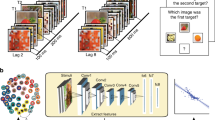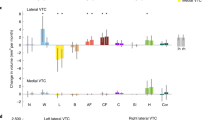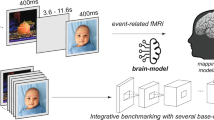Abstract
Virtually all cognitive theories of category learning (such as prototype theory1,2,3,4,5 and exemplar theory6,7,8) view this important skill as a high-level process that uses abstract representations of objects in the world. Because these representations are removed from visual characteristics of the display, such theories suggest that category learning occurs in higher-level (such as association) areas and therefore should be immune to the visual field dependencies that characterize processing of objects mediated by representations in low-level visual areas. Here we challenge that view by describing a fully controlled demonstration of visual-field dependence in category learning. Eye-tracking was used to control gaze while participants either learned rule-based categories known to recruit prefrontal-based explicit reasoning, or information-integration categories known to depend on basal-ganglia-mediated procedural learning9. Results showed that learning was visual-field dependent with information-integration categories, but we found no evidence of visual-field dependence with rule-based categories. A theoretical interpretation of this difference is offered in terms of the underlying neurobiology. Finally, these results are situated within the broad perceptual-learning literature in an attempt to motivate further research on the similarities and differences between category and perceptual learning.
This is a preview of subscription content, access via your institution
Access options
Access Nature and 54 other Nature Portfolio journals
Get Nature+, our best-value online-access subscription
$29.99 / 30 days
cancel any time
Subscribe to this journal
Receive 12 digital issues and online access to articles
$119.00 per year
only $9.92 per issue
Buy this article
- Purchase on Springer Link
- Instant access to full article PDF
Prices may be subject to local taxes which are calculated during checkout




Similar content being viewed by others
References
Homa, D., Sterling, S., & Trepel, L. Limitations of exemplar-based generalization and the abstraction of categorical information. J. Exp. Psychol. Human. Learn. Mem. 7, 418–439 (1981).
Posner, M. I. & Keele, S. W. On the genesis of abstract ideas. J. Exp. Psychol. 77, 353–363 (1968).
Reed, S. K. Pattern recognition and categorization. Cogn. Psychol. 3, 382–407 (1972).
Rosch, E. H. Natural categories. Cogn. Psychol. 4, 328–350 (1973).
Smith, J. D., & Minda, J. P. Prototypes in the mist: the early epochs of category learning. J. Exp. Psychol. Learn. Mem. Cogn. 24, 1411–1430 (1998).
Estes, W. K. Array models for category learning. Cogn. Psychol. 18, 500–549 (1986).
Medin, D. L. & Schaffer, M. M. Context theory of classification learning. Psychol. Rev. 85, 207–238 (1978).
Nosofsky, R. M. Attention, similarity, and the identification-categorization relationship. J. Exp. Psychol. Gen. 115, 39–57 (1986).
Ashby, F. G. & Maddox, W. T. Human category learning. Annu. Rev. Psychol. 56, 149–178 (2005).
Ashby, F. G., & Maddox, W. T. Human category learning 2.0. Ann. N. Y. Acad. Sci. 1224, 147–161 (2010).
Poldrack, R. A. et al. Interactive memory systems in the human brain. Nature 414, 546–550 (2001).
Poldrack, R. A. & Packard, M. G. Competition among multiple memory systems: converging evidence from animal and human brain studies. Neuropsychologia 41, 245–251 (2003).
Squire, L. R. Memory systems of the brain: a brief history and current perspective. Neurobiol. Learn. Mem. 82, 171–177 (2004).
Ashby, F. G., Alfonso-Reese, L. A., Turken, A. U. & Waldron, E. M. A neuropsychological theory of multiple systems in category learning. Psychol. Rev. 105, 442–481 (1998).
Maddox, W. T., Ashby, F. G., Ing, A. D., & Pickering, A. D. Disrupting feedback processing interferes with rule-based but not information-integration category learning. Mem. Cogn. 32, 582–591 (2004).
Waldron, E. M., & Ashby, F. G. The effects of concurrent task interference on category learning: evidence for multiple category learning systems. Psychon. Bull. Rev. 8, 168–176 (2001).
Zeithamova, D., & Maddox, W. T. Dual-task interference in perceptual category learning. Mem. Cogn. 34, 387–398 (2006).
Ashby, F. G., & Gott, R. E. Decision rules in the perception and categorization of multidimensional stimuli. J. Exp. Psychol. Learn. Mem. Cogn. 14, 33–53 (1988).
Ashby, F. G. & Ennis, J. M. The role of the basal ganglia in category learning. Psychol. Learn. Motiv. 46, 1–36 (2006).
Filoteo, J. V., Maddox, W. T., Salmon, D. P. & Song, D. D. Information-integration category learning in patients with striatal dysfunction. Neuropsychology 19, 212–222 (2005).
Knowlton, B. J., Mangels, J. A. & Squire, L. R. A neostriatal habit learning system in humans. Science 273, 1399–1402 (1996).
Nomura, E. et al. Neural correlates of rule-based and information-integration visual category learning. Cereb. Cortex 17, 37–43 (2007).
Jeter, P. E., Dosher, B. A., Petrov, A. & Lu, Z.-L. Task precision at transfer determines specificity of perceptual learning. J. Vision. 9, 1–1 (2009).
Simon, J. R., Sly, P. E. & Vilapakkam, S. Effect of compatibility of sr mapping on reactions toward the stimulus source. Acta Psychol. 47, 63–81 (1981).
Ashby, F. G. & Townsend, J. T. Varieties of perceptual independence. Psychol. Rev. 93, 154–179 (1986).
Ashby, F. G. & Soto, F. A. in The Oxford Handbook of Computational and Mathematical Psychology (eds Busemeyer, J. R., Townsend, J. T., Wang, A. & Eidels, A.) 13–34 (Oxford Univ. Press, New York, NY, 2015).
Soto, F. A., Zheng, E., Fonseca, J. & Ashby, F. G. Testing separability and independence of perceptual dimensions with general recognition theory: a tutorial and new r package (grtools). Front. Psychol. 8, 696 (2017).
Ashby, F. G., Ell, S. W. & Waldron, E. M. Procedural learning in perceptual categorization. Mem. Cogn. 31, 1114–1125 (2003).
Maddox, W. T., Bohil, C. J. & Ing, A. D. Evidence for a procedural-learning-based system in perceptual category learning. Psychon. Bull. Rev. 11, 945–952 (2004).
Maddox, W. T., Glass, B. D., O’Brien, J. B., Filoteo, J. V. & Ashby, F. G. Category label and response location shifts in category learning. Psychol. Res. 74, 219–236 (2010).
Spiering, B. J. & Ashby, F. G. Response processes in information–integration category learning. Neurobiol. Learn. Mem. 90, 330–338 (2008).
Crossley, M. J. & Ashby, F. G. Procedural learning during declarative control. J. Exp. Psychol. Learn. Mem. Cogn. 41, 1388–1403 (2015).
Maddox, W. T., Ashby, F. G. & Bohil, C. J. Delayed feedback effects on rule-based and information-integration category learning. J. Exp. Psychol. Learn. Mem. Cogn. 29, 650 (2003).
Yagishita, S. et al. A critical time window for dopamine actions on the structural plasticity of dendritic spines. Science 345, 1616–1620 (2014).
Maddox, W. T. & Ing, A. D. Delayed feedback disrupts the procedural-learning system but not the hypothesis testing system in perceptual category learning. J. Exp. Psychol. Learn. Mem. Cogn. 31, 100–107 (2005).
Ashby, F. G. & Valentin, V. V. in Handbook of Categorization in Cognitive Science 2nd edn (eds Cohen, H.& Lefebvre, C.) 157–188 (Elsevier, New York, NY, 2017).
Cantwell, G., Crossley, M. J. & Ashby, F. G. Multiple stages of learning in perceptual categorization: evidence and neurocomputational theory. Psychon. Bull. Rev. 22, 1598–1613 (2015).
Heimer, L. The Human Brain and Spinal Cord: Functional Neuroanatomy and Dissection Guide (Springer, New York, NY, 2012).
Waldschmidt, J. G. & Ashby, F. G. Cortical and striatal contributions to automaticity in information-integration categorization. Neuroimage 56, 1791–1802 (2011).
Gattass, R., Gross, C. & Sandell, J. Visual topography of v2 in the macaque. J. Comp. Neurol. 201, 519–539 (1981).
Hubel, D. H., Wiesel, T. N., Yeagle, E. M., Lafer-Sousa, R. & Conway, B. R. Binocular stereoscopy in visual areas v-2, v-3, and v-3a of the macaque monkey. Cereb. Cortex 25, 959–971 (2013).
Yu, C., Klein, S. A. & Levi, D. M. Perceptual learning in contrast discrimination and the (minimal) role of context. J. Vision. 4, 4–4 (2004).
Jeter, P. E., Dosher, B. A., Liu, S.-H. & Lu, Z.-L. Specificity of perceptual learning increases with increased training. Vision. Res. 50, 1928–1940 (2010).
Hung, S.-C. & Seitz, A. R. Prolonged training at threshold promotes robust retinotopic specificity in perceptual learning. J. Neurosci. 34, 8423–8431 (2014).
Dill, M. & Fahle, M. The role of visual field position in pattern-discrimination learning. Proc. R. Soc. London Ser. B 264, 1031–1036 (1997).
Nazir, T. A. & O’Regan, J. K. Some results on translation invariance in the human visual system. Spat. Vision. 5, 81–100 (1990).
Fahle, M., Edelman, S. & Poggio, T. Fast perceptual learning in hyperacuity. Vision. Res. 35, 3003–3013 (1995).
Petrov, A. A., Dosher, B. A. & Lu, Z.-L. Perceptual learning without feedback in non-stationary contexts: data and model. Vision. Res. 46, 3177–3197 (2006).
Ashby, F. G., Queller, S. & Berretty, P. M. On the dominance of unidimensional rules in unsupervised categorization. Percept. Psychophys. 61, 1178–1199 (1999).
Zhang, T., Xiao, L.-Q., Klein, S. A., Levi, D. M. & Yu, C. Decoupling location specificity from perceptual learning of orientation discrimination. Vision. Res. 50, 368–374 (2010).
Zhang, J.-Y. et al. Rule-based learning explains visual perceptual learning and its specificity and transfer. J. Neurosci. 30, 12323–12328 (2010).
Kahnt, T., Grueschow, M., Speck, O. & Haynes, J.-D. Perceptual learning and decision-making in human medial frontal cortex. Neuron 70, 549–559 (2011).
Kumano, H. & Uka, T. Neuronal mechanisms of visual perceptual learning. Behav. Brain Res. 249, 75–80 (2013).
Acknowledgements
This research was supported by the National Science Foundation Graduate Research Fellowship under grant no. 1650114, by NIH grant 2R01MH063760, and by NIH grant R01 EB018958. The funders had no role in the conceptualization, design, data collection, analysis, decision to publish, or preparation of the manuscript. Thanks to M. Casale, who worked on an earlier version of these experiments, and to M. Swiacki, A. Mar, B. Renard, K. Nunez, T. Timsit, E. Kim and C. Valtier for their assistance with data collection.
Author information
Authors and Affiliations
Contributions
L.A.R. and F.G.A. conceived and designed the experiment with input from M.P.E. L.A.R. managed data collection and analysed the data. L.A.R., M.P.E., and F.G.A. wrote the paper. All authors approved the final draft of the manuscript.
Corresponding author
Ethics declarations
Competing interests
The authors declare no competing interests.
Additional information
Publisher’s note: Springer Nature remains neutral with regard to jurisdictional claims in published maps and institutional affiliations.
Supplementary information
Rights and permissions
About this article
Cite this article
Rosedahl, L.A., Eckstein, M.P. & Ashby, F.G. Retinal-specific category learning. Nat Hum Behav 2, 500–506 (2018). https://doi.org/10.1038/s41562-018-0370-z
Received:
Accepted:
Published:
Issue Date:
DOI: https://doi.org/10.1038/s41562-018-0370-z
This article is cited by
-
Visual perceptual learning of feature conjunctions leverages non-linear mixed selectivity
npj Science of Learning (2024)
-
Category Learning Can Depend on Location-Specific Visual Representations
Journal of Cognitive Enhancement (2024)
-
Mouse visual cortex areas represent perceptual and semantic features of learned visual categories
Nature Neuroscience (2021)
-
Sensory category learning
Nature Human Behaviour (2018)



